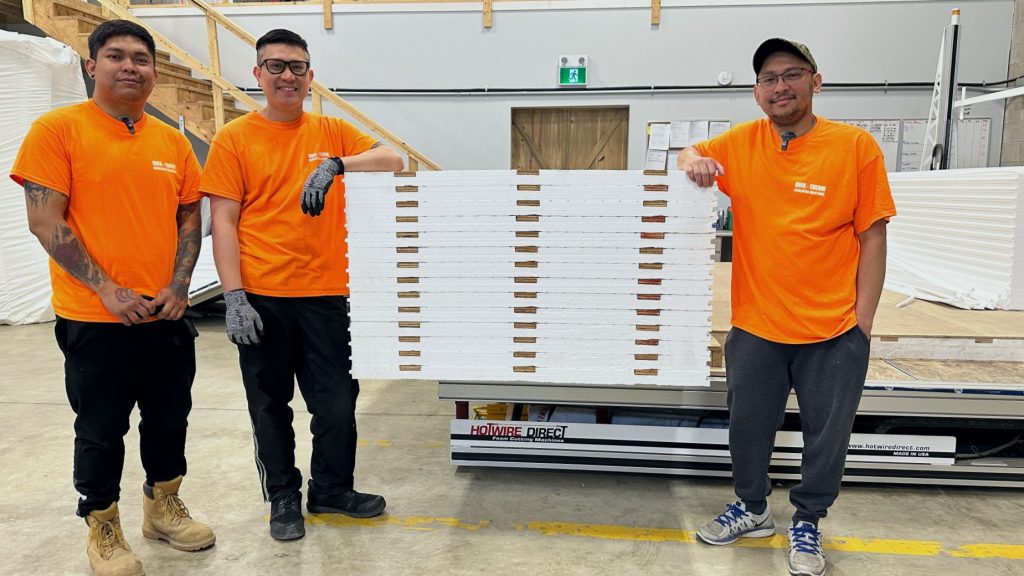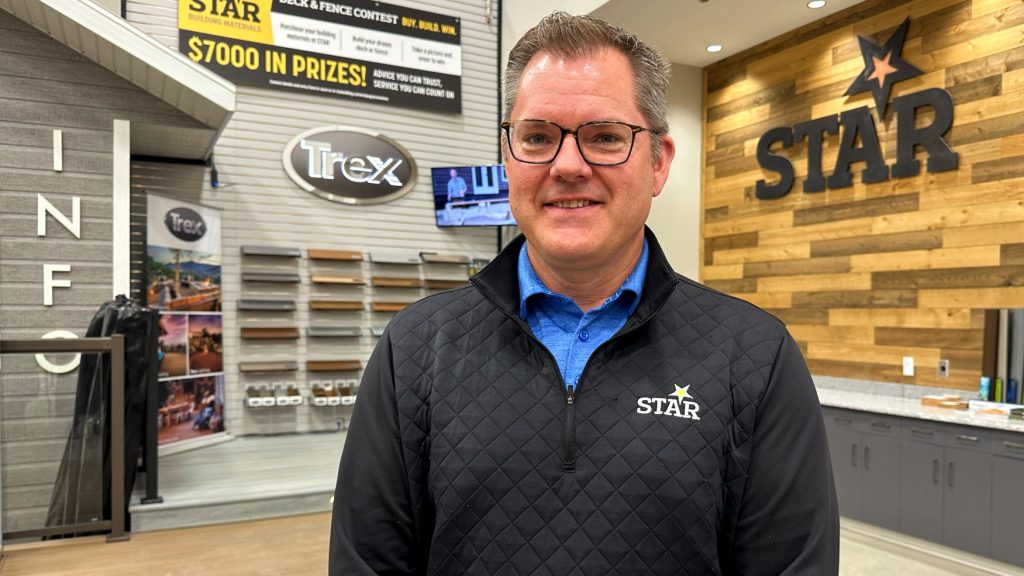Can newcomers to Canada solve the construction industry’s labour problems?
Posted May 26, 2024 8:43 pm.
Construction is a multi-billion-dollar industry that’s driving growth in Canada, but there’s a perfect storm of uncertainty on the horizon.
As the market continues to expand, a labour shortage is preventing the building industry from reaching its true potential. And in the next five years, 20 per cent of the workforce is set to retire, with not enough workers to replace them.
That’s problematic for an industry that did $7.2 billion in sales in 2019 in the Prairies alone.
With Canada’s population growing through immigration and the arrival of refugees, the labour shortage is resulting in fewer homes, exacerbating a housing crisis that’s gripped the country post-pandemic.
What does it all mean for the next few years?
One solution may be those very newcomers now calling Canada home, with a chance for new legacies within reach.
Enter the Winnipeg-based Western Retail Lumber Association (WRLA), which helps its member businesses – in the Prairies, B.C., northwestern Ontario, Northwest Territories, Yukon and Nunavut – grow in the industry.
“We’re here to support small to medium and large businesses that work in the building materials industry,” explained WRLA president Liz Kovach. “Our members produce and sell everything that goes into a building. So whether it’s a commercial building, residential or agricultural building, that’s what they do. And our job is to help them run really great, smooth businesses where we support their staff in their training needs and of course, their marketing needs as well to their customer space.
“Our industry and our association represents everything from start to finish. So whether it’s a tree that is harvested and processed into lumber, whether it’s siding that started out as a steel coil and has now been manufactured into something that looks beautiful on the outside of your home, whether it’s the insulation that you don’t see but you appreciate when it keeps you cool or hot depending on the time of year it is. All of those, from start to finish, our members produce.”
RELATED: Canadian lumber industry grappling with thousands of unfilled jobs
But the construction industry is so much more than a collection of lumber, sidings and insulation, according to Kovach. It’s about “building communities,” she says.
“When you walk into a local lumber store, you’re not actually stopping to think about what that entails because you just need something. Whether you need a screw, whether you need wood, whatever it is that you need. But those folks really are helping the construction sector build communities.
“And I know a lot of people don’t see that,” she added.
‘There’s always going to be a need’
What Kovach sees are the signs: a struggling economy, the labour shortage, an increasing population, the housing crisis.
“We’re always going to be building, there’s always going to be a need and we see there’s growth everywhere that’s required,” she said. “We’re really going to start to see the shift once the interest rates go down and once our economy starts to pick up on the building side. We’re really going to see the impact of how much needs to be built here in Canada.”
That’s where the WRLA is taking an active role in trying to make it easy for newcomers to learn about the industry and “build their career from there.” Kovach says bringing new faces to the industry is essential to keep it moving – and keep a roof over everyone’s heads.
“For newcomers, this is a great place to come,” the association’s president said. “We have so many of our organizations that have such a cultural diversity. If you go through all of our plants, you’ll get to see the flags of all the cultures that are represented and it’s really amazing to see. You can see the diversity on the floor, people are working really well together and there’s definitely some training there to help people succeed and excel.
“We’ve seen a lot of newcomers to Canada who have found some interest, and I have heard of a lot of them now and it’s really cool because now we get to work with them on some of their training and development as well. It’s fun to be a part of that.”

Kovach says no matter what the skillset, there’s room in the building industry for people to come work. Part of that is because the WRLA provides education and training that specifically caters to varying levels of skills and experiences. It’s also, according to Kovach, because nearly every skill is transferrable to the sector.
“I’m a great example,” she told CityNews. “I was training to be an athletic therapist, now I’m working in the building supply industry. I would have never been able to plan this. As you learn and as you start to understand what some of your strengths are and your interests lie, that’s when you start to create that shift.”
Career change for immigrants to Canada
More great examples are not hard to come by.
At Winnipeg’s Quik-Therm Insulation, a manufacturing plant on Sargent Avenue, Canadian immigrants are working hard in an industry that was once foreign to them.
Michael Bernardino and his coworkers Neil Aguilar and Jotham Benedicto may no longer be considered newcomers to Canada – they all immigrated from the Philippines in the early to mid-2010s – but they’re certainly newcomers to construction, helping to fill a gap left by the growing shortage of workers in the sector.
They all came to Canada hoping for more opportunities for themselves and their families.
Bernardino, who has been working at Quik-Therm for two years, gave CityNews a warehouse tour, where expanded polystyrene sheets are turned into insulation.
“We have stocks ready to laminate,” said the 42-year-old. “We cut blocks, (depending) on the order of the customers.”
Then comes lamination, which Bernardino calls his favourite part of the process.
“So basically we run it through (the laminator machine), to put a film on top and below the styro… It’s gonna be laminated from bottom and top. Then it’s gonna go through this perforator, it puts some tiny holes for water and air to evaporate… Then we stack them and bag them.”
Bernardino’s entry into the building industry was unplanned and unexpected. An experienced nurse, he immigrated to Canada in 2014 from Angeles City in the Philippines to join family in Winnipeg.
“I was a bit disappointed because of how strict the regulatory body of nursing here before. So then why not shift to another business?”
—Michael Bernardino
“Back then I was still living with my brother, so I don’t want to be a burden to them, so I need to find a job to help financially.”
Bernardino found a job at a warehouse, and it eventually led to him working at Quik-Therm. Aguilar and Benedicto later joined him at a job they all say doesn’t even feel like work.
“No stress. Even after work, you can go home (with) no stress,” described Aguilar, who came to Canada from Quezon with his uncle in 2012. “Unlike other warehouses, where first thing in the morning you’re already tired. But here, you will never get tired.”
“We treat each other as a family,” Bernardino said. “So there’s no stress, all of us are happy, and at the end of the day, you just played and not work. I think that’s the most important part. You enjoy what you’re working.”
“It is fun,” added Benedicto. “That’s the most important thing, right? You’re going out in the morning and then you’re excited going to your job and all the people here. We’re all family here. It’s a family business and that’s why, my first day here, even my interview when I came here, I felt like I’m home. This is like home. Even the warehouse, it feels like it’s not a warehouse.”

Benedicto, who left Manila with his wife and three kids in 2017, is the newest member of the Quik-Therm team, with three months under his belt.
“When I had my children, me and my wife decided to move here for more opportunity and hope for a safer and better future for my kids,” he said.
Ryan Cullen, Quik-Therm’s director of operations, calls working in Manitoba “a blessing.”
“It’s cool to see your home province and working with people in your home province and getting it out the door and then going all throughout Canada,” Cullen said. “We’re going up north to Nunavut, into the Yukon, to Northwest Territories and having an impact. I think it’s just, from my standpoint, it’s just cool being involved in a Manitoba company and then making a difference all throughout Canada.”
Coming from three different places in the Philippines and three different employment backgrounds, Bernardino, Aguilar and Benedicto all had hesitations entering an industry they knew little about. Now they’re in the midst of a new career.
“I’m looking forward to more years in here and hopefully I will improve myself and I have my career growth here,” said Benedicto.
The three friends are not sure what the future holds, but they know their company will be behind them. Aguilar, for one, is headed to Red River College soon to study IT; Quik-Therm made it clear he has a job with them both during and after his schooling.
As the company grows and it needs more members, Bernardino and his colleagues have turned into de facto recruiters.
“I’m thinking of our friends, to get them to work with us, to experience this kind of vibe,” Bernardino said. “Like family thing in the workplace. I think that would be great for us and hopefully for them, too.
“To other Filipinos here in Canada, if you want to work in this kind of industry, why not try it? Maybe you’ll like it.”
And it’s not just Filipino immigrants who are joining the building sector. The Western Retail Lumber Association says it’s seeing newcomers to Canada from all over the world deciding to give the industry a try, and as a result has been developing materials specifically meant to support people whose first language is not English.
‘For young people in our industry, the opportunity is amazing’
The building industry isn’t just about manufacturers and construction workers, as there are diverse jobs in the sector, such as shipping, manufacturing, sales, marketing, IT, HR, management and customer service.
Industry leaders say the labour shortage extends to those facets of construction as well. It has them touting the benefits of a career in construction.
Mark Kennedy, the vice-president of operations at STAR Building Materials in Winnipeg, says the potential career growth in the construction industry is extremely promising.
“For young people in our industry, the opportunity is amazing,” said Kennedy, who turned a part-time gig at a construction company into a 35-year-career. “There is a ton of older guys like myself that are looking at the end of our careers and potentially looking to retire. And right now you can write your own ticket if you’re a young person who wants to work hard and learn the business, you can really do well in this industry.
“With the expansion and the housing troubles that there’s been recently, it’s hard to find good people, and experienced people are very hard to find. It’s a very competitive market, so finding those good people and retaining them is probably our biggest challenge.”
STAR is a company that supplies building materials to contractors and to home builders.
“A lot of it all starts from here,” Kennedy said. “So every project that you see that’s going up where you see cranes or construction or anything all starts from a lumber yard.”

What began as a “little homegrown business” in Winnipeg grew into what it is today, with Kennedy feeling the success of the store mirrors anyone’s potential for growth in the industry.
“We had (a) gravel lumberyard,” the vice-president of operations recalled. “If it rained, it was these big puddles that were coming in. The warehouses were falling over. Our store was tiny and we had everybody tripping over everybody.
“During COVID, we probably would have had to shut down if we stayed in that spot. So we knew that this was a big task for us in order to rebuild and rebrand of who we were and who we wanted to be.”
Following that “much-needed upgrade,” STAR Building Materials now has a renovated retail space, a seven-acre shipping and lumber yard, and multiple warehouses.
Much like the company, Kennedy’s own career grew over the years. He worked at a lumber company through school and turned that into a full-time job after graduation.
“From there it’s just opportunity after opportunity came by,” he said. “It took me to Vancouver and the West Coast … and then that brought me back to Winnipeg where through a couple different opportunities again, I ended up at STAR and now I’m running the business.
“I don’t think I’ve ever applied for a job. It was basically just an opportunity came upon itself from company to company and slowly moved up and just worked hard at what we were doing and you get recognized.”
Kennedy hopes his story inspires others to take a chance in an industry that desperately needs new faces. With a fifth of the workforce retiring in the coming years, it spells uncertainty for the near future.
But the impending gap in the building sector also opens a world of possibilities – for immigrants, young Canadians, or anyone looking to learn and grow and be part of the next generation building Canada’s future.








